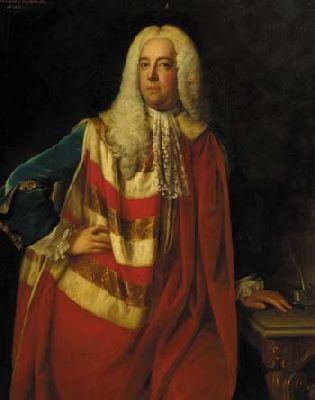Residence Mount Felix Name Charles 4th Occupation Gentleman | Nationality English | |
 | ||
Other names Lord Ossulston (from 1753 to 1767) | ||
Charles Bennet, 4th Earl of Tankerville (15 November 1743 – 10 December 1822), styled Lord Ossulston from 1753 to 1767, was a British nobleman, a collector of shells and a famous patron of Surrey cricket in the 1770s. He agreed a set of cricket rules that included the first mention of the Leg before wicket rule. His wife, Emma, was also notable as a collector of exotic plants. Her collection of over 600 illustrations were purchased by Kew Gardens in 1932 and are still available today.
Contents
Biography
Tankerville was born in 1743 and was educated at Eton College between 1753 and 1760. Having succeeded to the Earldom on the death of his father on 27 October 1767 he married Emma, daughter of Sir James Colebrooke, 1st Baronet, in 1771 and settled at Walton on Thames at his house, Mount Felix overlooking the Thames.
Lady Tankerville amassed a large collection of exotic plants at Mount Felix. Emma Tankervilles collection was thought to be the largest in the London area. Specimens named after Lady Tankerville include the Nun's Orchid or Phaius tankervilleae. Artists were employed to create botanical drawings on vellum of the specimens.
Tankerville often played cricket and seems to have been a very good fielder, though he was not especially noted for batting or bowling. He was the employer of Edward "Lumpy" Stevens, who was a gardener at Tankerville's Walton-on-Thames estate; and William Bedster, who was his butler. It was the accuracy of "Lumpy" Stevens that led to the introduction of a middle stump. Prior to 1776 there were only two stumps and Lumpy's deliveries could go through the hole. A permanent memorial to Lumpy Stevens has been proposed.
In 1774, Tankerville sat on the committee that formulated some early laws of cricket. They were settled and revised at the Star and Garter in Pall Mall on Friday 25 February 1774. The meeting was chaired by Sir William Draper and the committee included the Duke of Dorset, Harry Peckham and other "Noblemen and Gentlemen of Kent, Hampshire, Surrey, Sussex, Middlesex, and London". This meeting was one of the earlier sets of cricket rules and is acknowledged as being the first where the Leg before wicket rule was introduced.
Tankerville continued in his interest in cricket with Chertsey and Surrey Cricket club until 1781 when he retired from the sport and went into politics. He was appointed joint postmaster general and a privy councillor in 1782, but he resigned his office in April 1783. However Tankerville was again appointed under Mr Pitt's administration in January 1784. He died on 10 December 1822 and was succeeded by his eldest son Charles Augustus.
Legacy
Tankerville's other interests included maps and shells. At the end of his life his collection was sold for an undisclosed sum, but thought to be between three and four thousand pounds. There are a number of flowers, shells and gastropods with the Latin name tankervillii. The gastropod named Amalda tankervillii (Swainson, 1825) is probably named for Tankerville (or less probably his son).
Tankerville married Emma Colebooke on 7 October 1771 in Gatton, Surrey. She was co-heir to her father Sir John Coleborrke. His wife's collection of botanical illustrations are still held at the Royal Botanical gardens, an orchid is named in her honour and the gardens at Mount Felix were well regarded many years after her death.
In addition, their daughter Lady Mary Elizabeth Bennet (21 May 1785 to 27 Feb, 1861) worked with her Father's gardener (William Richardson) to cultivate new strains of tri-colored viola pansy flowers that were presented to the botanical society and horticulture groups in 1812 with wide acceptance. Lady Mary Elizabeth Bennet was also an accomplished artist in watercolor and was invited to many exhibitions. She was trained by London artist John Varley. Her works are on exhibit and in private collections including a composition of her home at Belsay Castle rendered in 1834 after her marriage on 26 July 1831 to Sir Charles Miles Lambert Monck, Bt. The painting of her home at Belsay Castle in Northumberland by Lady Mary Elizabeth Monck was found to be included as part of the Monck estate in 1912 and now resides in a private collection in the US. Another of her works is the Burial Place of the Breadalbanes from the Churchyard at Killin done in 1826-1827 on a trip to the Scottish highlands with her brother. This haunting graveyard work may have been inspired by the seat of her Father's estate as the Earl of Tankerville being at Chillingham Castle which is rumored to be quite haunted. From 1815 to 1823 (before her marriage) artist Lady Mary Elizabeth Bennet also trained and worked with the genius London artist John Linnell in engraving as well as miniature painting on ivory. They together produced a set of (12) engravings about Chillingham Castle that were started in 1815 and not finished and published until 1818.
The Hon Henry Grey Bennet, their second son, became the member of parliament for Shrewsbury in 1806 whilst their third son, The Hon John Astley Bennet, became a captain in the Navy but died in September 1812. The 5th Earl, Charles Augustus, who was born on 28 April 1776 was treasurer of the household during the short administration of Mr Fox in 1806. Their daughter Corisande Emma Bennett married James Harris, 3rd Earl of Malmesbury on 13 April 1830.
